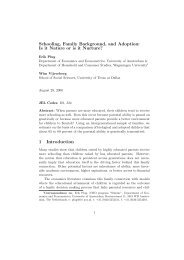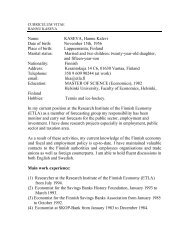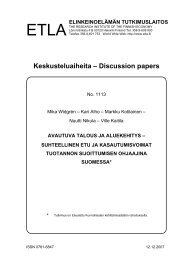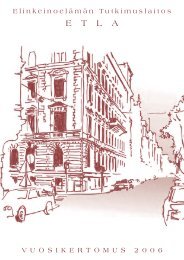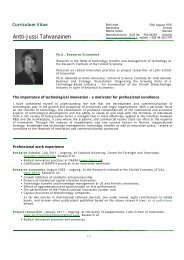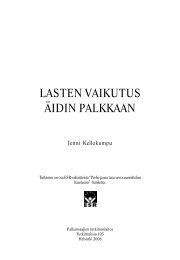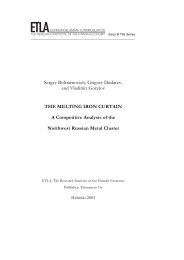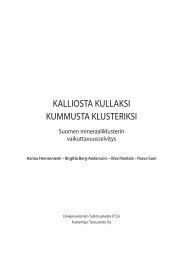Download PDF - Etla
Download PDF - Etla
Download PDF - Etla
Create successful ePaper yourself
Turn your PDF publications into a flip-book with our unique Google optimized e-Paper software.
8<br />
dependencies? There are different types of interdependence, some of which are more intensive<br />
and more difficult to manage than others (Thompson, 1967).<br />
3. Gain qualitative in‐depth empirical insight from interviews with both manufacturing and<br />
R&D management, and explorative quantitative analyses using secondary databases (Sections<br />
4, 5, and 6 of this article).<br />
Because the cross‐functional dependencies view is the only perspective that explicitly addresses<br />
co‐location and where a promising extant theoretical base exists, it may prove to be<br />
the best candidate for explicit in‐depth studies of co‐location. This is not to say that the two<br />
other views are irrelevant, but it seems to be the case that they may not hold as much promise<br />
in shedding light on co‐location. Of course, all three are highly relevant in studies of R&D<br />
and manufacturing location decisions and should receive their fair share of theoretical and<br />
empirical attention.<br />
This paper lays the foundation for the development of measurement instruments that can<br />
subsequently be used in large‐scale surveys and help draw statistical generalizations regarding<br />
co‐location.<br />
3. DISSECTION OF R&D AND MANUFACTURING<br />
3.1. MANUFACTURING<br />
There are many ways one might dissect the manufacturing function into its constituent parts<br />
for analysis. However, distinguishing between routine vs. non‐routine activities appears most<br />
useful as the primary dimension, because it has direct implications to the need for crossfunctional<br />
cooperation: routine activities are those activities performed without explicit need<br />
for problem‐solving, while non‐routine activities often involve at least some crossing of functional<br />
boundaries.<br />
Routine manufacturing includes activities that can be performed independently from other<br />
activities and other functions, and there are typically standard procedures for executing<br />
these activities. These activities can usually be run as parts of a ”closed system” (Thompson,<br />
1967) in that routine manufacturing activities can be assigned to the manufacturing function<br />
and executed fully within the manufacturing function, without cross‐functional dependencies.<br />
These routines include the following activities, the most routinized activities first:<br />
1. Production activity control (PAC): finite scheduling of individual workstations and the<br />
execution of detailed production steps;<br />
2. Production planning;<br />
3. Inventory management (managing work‐in‐process [WIP] inventory);<br />
4. Routine technology management (e.g., maintenance of equipment);<br />
5. Supply chain management (inbound and outbound logistics).<br />
Non‐routine activities, in turn, are those where manufacturing has an important role (perhaps<br />
even the most important functional role), but may not be able to operate independently<br />
of other functions and perhaps the strategic decision‐maker (business unit and corporate<br />
management). These are, with the least routinized activities listed last:<br />
6. Implementing engineering change orders (ECO) to existing products;



